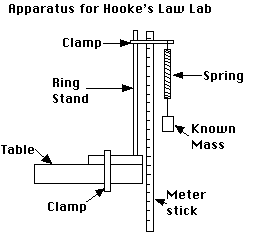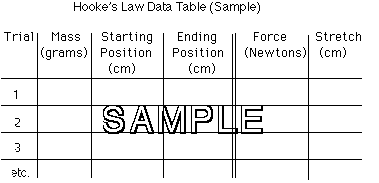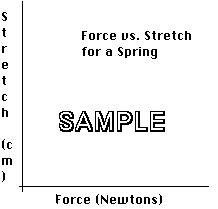Physics 1
Dynamics Experiment
How Does A Spring Scale Work?
Hooke's Law


![[Index]](../../../NavIcons/Up.GIF)
![[Home]](../../../NavIcons/Home.GIF)
![[Help]](../../../NavIcons/Help.GIF)
Purpose:
- To investigate Hooke's Law (The relation between force and
stretch for a spring)
- To investigate Newton's Laws and the operation of a spring
scale.
Discussion:
Everybody knows that when you apply a force to a spring or a
rubber band, it stretches. A scientist would ask, "How is the force
that you apply related to the amount of stretch?" This question was
answered by Robert Hooke, a contemporary of Newton, and the answer
has come to be called Hooke's Law.
Hooke's Law, believe it or not, is a very important and
widely-used law in physics and engineering. Its applications go far
beyond springs and rubber bands.
You can investigate Hooke's Law by measuring how much known forces
stretch a spring. A convenient way to apply a precisely-known force
is to let the weight of a known mass be the force used to stretch the
spring. The force can be calculated from W = mg. The stretch of the
spring can be measured by noting the position of the end of the
spring before and during the application of the force.
Equipment:
|
spring
|
rubber band
|
ring stand
|
|
|
ring-stand clamps
|
c-clamp
|
spring scale
|
ruler or meter stick
|
|
set of known masses
|
|
|
|

Safety Notes:
- Be sure to keep your feet out of the area in
which the masses will fall if the spring or rubber band breaks!
- Be sure to clamp the ring stand to the lab table, or weight it
with several books so that the mass does not pull it off the
table.
- You need to hang enough mass to the end of the spring to get a
measurable stretch, but too much force will permanently
damage the spring. (An engineer would say that it has
exceeded its "elastic limit"). "You break it, you
bought it."
Procedure:
- Assemble the apparatus as shown in the diagram at right. Be
sure to clamp the ring stand to the lab table, or weight it with
several books.
- Construct a data table. You will need to record the mass that
you hang from the spring and the position of the end of the spring
before and after the mass is added. From this, you will calculate
the force applied to the spring and the resulting stretch of the
spring. You should allow for at least 8-10 trials. (A sample data
table is shown below.)
- For each trial, record the mass, the starting position of the
spring (before hanging the mass) and the ending position of the
spring (while it is being stretched).
- Repeat the process for a rubber band.


Results:
- Calculate the force applied to the spring/rubber band in each
trial (W = mg) Use g = 9.8 m/s2.
- Calculate the stretch of the spring/rubber band in each trial
(the difference in the starting and ending positions).
- Draw graphs of force versus stretch for the spring and the
rubber band. You may be able to put both graphs on the same sheet
of graph paper, depending on the data.
Conclusions:
Hooke's Law says that the stretch of a spring is directly
proportional to the applied force. (Engineers say "Stress is
proportional to strain".) In symbols, F = kx, where F is the force, x
is the stretch, and k is a constant of proportionality. If Hooke's
Law is correct, then, the graph of force versus stretch will be a
straight line.
Do your results confirm or contradict Hooke's Law? Please
elaborate.
Questions:
Examine a spring scale. It is a simple device that measures force
by measuring the amount that the force stretches a spring.
- Hang an object (at rest) from the spring scale. Draw a set of
diagrams that shows all of the forces that act:
- on the object
- on the spring scale
- What is the net force on:
- the object?
- the spring scale?
- Are the forces that act on the object equal and opposite? Are
they a Newton's Third Law force pair?
- Are the forces that act on the spring scale equal and
opposite? Are they a Newton's Third Law force pair?
- For each force in your diagrams (question 1), indicate its
Newton's Third Law "partner". Be sure to indicate (a) what the
force pushes or pulls on, and (b) its direction.
adapted from Robinson, Conceptual Physics Laboratory
Manual, Addison-Wesley, Experiment 15, Tug-of-War


![[Index]](../../../NavIcons/Up.GIF)
![[Home]](../../../NavIcons/Home.GIF)
![[Help]](../../../NavIcons/Help.GIF)
last update November 6, 2002 by JL
Stanbrough